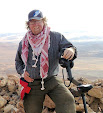Second one is from this season and is one of several taken from the helicopter. At about 11 seconds in there is a view of some typical Ottoman Army camp tent rings, still present from their defence of the railway during the First World War.
More will be added when we are able to use a better internet connection.
In the meantime, news from the desert...
At Tel el Shahm the team was today divided into 5 groups this morning. The first group stayed there and field walked the area to the south towards the station.
The field walkers and detectorists uncovered a variety of metal finds associated with the military occupation, both at the site of the tent rings and towards the railway itself. Also around the base of the southern side of the hilltop on which the fortification stands a major prehistoric site is clearly in evidence, proving a very excited find for David Thorpe and the team members present there today.
The other four teams walked the remaining un-surveyed section of the Hijaz railway south to Mudawwara, in four separate portions. One began at the ruins of Ramlah station and headed south. Near the station was found 1 Mauser cartridge and the remains of a defensive crenulated ottoman trench about 100 metres east of the station. They then followed the line in earnest and immediately encountered a small hill adjacent to the east of the line. The hill had been trashed but from it looking south we saw several parallel rows of tent rings at right angles to the railway line. About 200 metres further east on a low ridge were three roughly circular fine sand areas which are redolent of mule lines. Returning west to the railway we found several more rows of tent circles. Then, following the line to the south, where after about one kilometre to the east of the line, several more rows of tent rings were encountered on low ridges. All these features were systematically recorded in terms of their GPS location, sketch maps and photographs. This pattern continued for another two kilometres at various locations, always to the east of the line. Basically after a days walking they had covered 4 kilometres of the planned 12, having been ambushed by the incredible high density of relevant features. Roughly about 7 camp sites and 80 or more tent rings, some of which were almost certainly prehistoric.
The second team started from the outskirts of Mudawwara and went north towards the others with the aim of meeting half way. Leaving Mud with the brilliant green irrigated fields to the east, we entered a wide flat plain that rose gently to a low red sandstone hill that was heavily fortified with blockhouses and round towers. An old railway cutting about 300m in length was seen to the west of the line, and this was also recorded. Continuing to follow the railway line to the north, their attention was captured by a prominent hill 400 metres to the west of the line. Around the base of this was a tent ring encampment with around 35 rings and a network of footpaths leading down to the line. A steep rock cut path led to the top of the hill where a walled enclosure formed a hill top fortification. The walls survived to about 2 metres in height and contained loopholes. The fort completely dominated the landscape.
The discoveries by these two teams typified the day – there is clearly a wealth of hitherto undiscovered and not yet investigated features on this sector of the railway. It looks like we will have our work cut out for the remaining years of the project to examine and record these amazing remnants of the Great Arab Revolt.





No comments:
Post a Comment